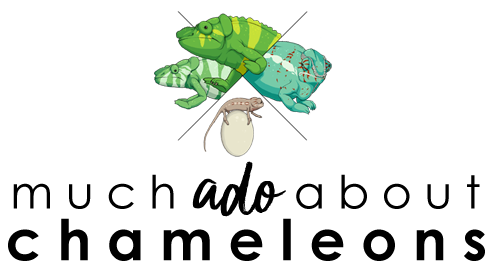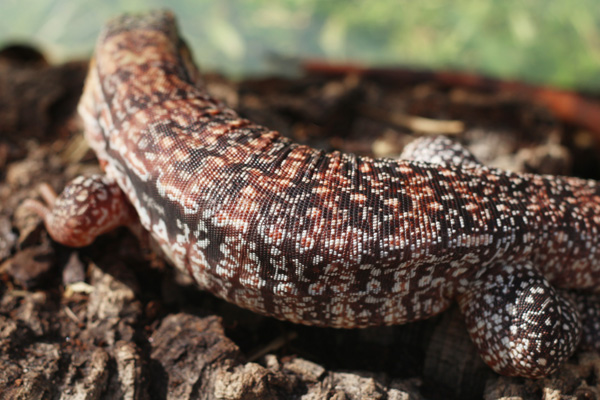Particularly in the United States, there is typically a reptile show once a month in one state or another. Florida and California in particular are hot spots for reptile breeder expos and are a great place to spend a few hours looking at snakes, lizards, invertebrates, and a few exotic mammals, find lots of reptile supplies in a single place without having to pay shipping, and purchase animals for typically reduced prices. I myself have brought home many pet reptiles from these events and always have a great time looking around and saying hi to reptile vendors or enthusiasts I know.
However, with one of the bigger expos all year right around the corner here in Florida, I thought it was a good time to put out a small word of caution when purchasing animals (for the purpose of this blog, specifically chameleons) at these shows. I purchased my first chameleon ever at this same show a few years ago and want to share a few things to look out for and some tips.
 |
| A healthy-looking male panther in an appropriate screen cage with vines and foliage at a local show. |
SOURCE OF THE ANIMAL
This is an important one. A lot of the animals at these expos are captive bred but a good number of them are wild caught, meaning that they were captured in their native country and imported into the country, typically just in time for the show. What the latter means is that you stand the risk of buying an animal that has not had any time to acclimate to captivity, much less acclimate to the country before being put on display in a cage for hundreds or thousands to see. Or an animal that has come in very dehydrated and stressed and has not been given the time to settle in, drink, and regain their strength before being put on display. Or an animal that is infested with parasites, which is a situation made worse by being put on display. Or all of the above at once.
WHEN CONSIDERING AN ANIMAL FOR PURCHASE...
To avoid buying an animal that may be so stressed, dehydrated, and weakened by the whole process that you take them home essentially to die, there are some things to keep in mind.
1. Ask the vendor for the source of the animal. Was it captive bred (CB) or wild caught (WC)? A reputable breeder will be happy to tell you.
 |
| A Meller's chameleon. Sunken eyes & very skinny, definitely avoid. |
2. Inspect the animal carefully. Some vendors are not above lying. Is the animal pitch black? Is it keeping its eyes closed? Is the animal lethargic or listless? Is it very thin? Are their eyes sunken in? Can you see what look like thin worms under the skin? Is it covered in bruises, scrapes, cuts, or injuries? These are all signs of a WC chameleon, or at the very least a sick one.
3. How are the animals housed? Typically, WC chameleons are not worth much in the eyes of the vendors and will be housed together in large numbers with minimal thought into their comfort. This includes males and females together, perhaps even different species together. A reputable breeder will put chameleons into individual cages, or at the very least separate the males and keep females in small groups, and put some sort of vegetation in the cage with them and some lighting for heat. Avoid chameleons kept in little deli cups, this shows a total disregard for the animal's needs. This is fine for snakes and geckos but totally inadequate for a chameleon for more than a short drive home.
4. Is the vendor knowledgeable about the animal? Someone who breeds animals will have to be familiar with the care of species, and more so with chameleons than with other animals. A vendor who is competent in answering your specific questions is more trust-worthy than one who has no clue or offers incorrect information. Someone who doesn't know about the species they are selling are probably not breeders but just dealers, who receive animals (possibly WC) and then just turn around and sell them.
As an example of someone who takes their animals seriously, here is the business card from a company called Ohio Gecko, from whom I've purchased geckos before. I was impressed to see that on the back of their business card they have a care sheet for leopard geckos, which shows that even if the buyer never does another ounce of research, that they have the very basics right on the back of their card. They also encouraged me to contact them if I had any more questions. I think breeders that want to give you a care sheet and encourage contact is a reputable one indeed.
SPECIAL NOTE ON PANTHERS
Panthers are more expensive chameleons and may not be available at reptile shows very often, but when they can be largely CB, depending on the show. This is good news, but there are still things to be very careful about. The biggest concern is locale honesty, which is a tricky thing to navigate. To be able to identify whether you are looking at a pure locale individual or a cross takes a lot of becoming familiar with photos/individuals from each locale and training your eye to spot the differences. And even then it can become tricky, as not all offspring from a cross clutch will look like mixes and may look like either pure parent locale.
1. Look for pet-only panthers. Do not go to find potential breeder stock from shows unless the vendor is a very reputable breeder or you are great at identifying the different locales in adults (in males only). Some prior research on who will be vending before the actual show goes a long way in determining who these are. Reputable breeders will be able to tell you accurate information about chameleons, should be able to show you the parents of any babies, and have both babies and adults properly housed during the show. If the vendor is not fitting this ideal, consider buying a panther as a pet-only animal, as to avoid any head-aches with breeding crosses down the line.
2. Avoid vendors that have mixed different locale females together. This is a huge red-flag for me. I once saw a cage with many females, advertising both Nosy Be and Ambilobe females. However, females all look the same, regardless of locale, so by mixing them together there is now no way to tell them apart. It strikes me as highly unethical for them to pull out and sell an Ambilobe female to someone inexperienced when they have no idea which of the two they are handing out. If they are this careless now, who's to say that they aren't just as careless when breeding, or doing day-to-day maintenance on their animals?
3. Do not buy baby panthers from a non-reputable breeder. Buying an adult because you like his or her colors as a pet chameleon is one thing, but do not buy a baby if you do not trust the expertise of the vendor, for reasons listed above. This is a good way to end up with the gender you did not want, such as a female instead of a male, because young panthers all look the same and someone inexperienced is much more likely to sex them incorrectly, or they will turn out to not be the locale/color you wanted. This probably means you will end up spending more money for a chameleon you didn't really want.
AFTER THE PURCHASE
If you do find a chameleon that you bring home, congratulations! It's very exciting to bring your new pet home. Make sure to make the trip from the show to your home as short as possible (so no stopping for a long lunch!) and preferably you should have a cage ready for them at home. Remember that they have had a very stressful weekend (packing up at their first home, travel to the show, put out on display, packed away at night, put on display again the next day...) so put them in their new cage, provide lots of water, and leave them alone as much as possible. Give them a few days to settle in properly and then start handling your new chameleon. But allow them to drink, eat if they want, and settle in with peace and quiet.
--
In conclusion, reptile shows are a great place to socialize with other reptile keepers, find great deals on supplies and feeders, and find lots of possible new pets. You just have to be careful to avoid bringing home a heartache. I certainly attend several a year and always have a great time.















เล่นเลย เครดิตฟรี joker123 slot online แจกโบนัสมากมาย
ReplyDeletehttps://www.slotxd.com/jokergaming123
nice info about buying chameleons
ReplyDeletereptile chameleon